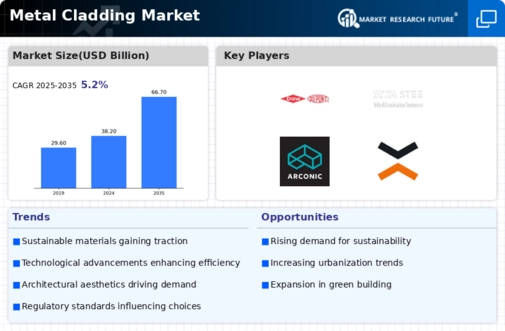Leading market players are investing heavily in research and development in order to expand their product lines, which will help the Metal Cladding market, grow even more. Market participants are also undertaking a variety of strategic activities to expand their footprint, with important market developments including new product launches, contractual agreements, mergers and acquisitions, higher investments, and collaboration with other organizations. To expand and survive in a more competitive and rising market climate, Metal Cladding industry must offer cost-effective items.
Manufacturing locally to minimize operational costs is one of the key business tactics used by manufacturers in the Metal Cladding industry to benefit clients and increase the market sector. In recent years, the Metal Cladding industry has offered some of the most significant advantages to medicine. Major players in the Metal Cladding market, including Saint Gobain S.A, Dow Du Pont, Tata steel limited, Arconic, Westlake chemicals, Etex group, and James Hardie industries, are attempting to increase market demand by investing in research and development Material Types.
A diverse and integrated steel manufacturer is Tata Steel Ltd. Its operations span the entire value chain, from raw steel production to completed steel products. The business sells bearings, agricultural tools, building materials, and flat goods. It offers services to the automotive, building, general engineering, industrial, and agricultural markets. Additionally, it runs captive iron ore mines and collieries near the Indian cities of Jamshedpur, Kalinganagar, and Dhenkanal. The business is also present in a number of downstream industries that contribute value. It conducts business in Australia, China, Thailand, Singapore, Vietnam, China, the United Kingdom, and the Netherlands.
The headquarters of Tata Steel are in Mumbai, Maharashtra, India. A Centre for Innovation in Mining and Mineral Beneficiation was created by Tata Steel in February 2023 at the Indian Institute of Technology (Indian School of Mines), Dhanbad.
A company that manufactures building materials is Kingspan Group Plc (Kingspan). It creates, produces, and sells energy storage products. Rigid insulation boards, insulated roofs, walls, facade systems, insulated panels, access floors, steel frames, and off-site wood frame solutions are among the many goods the company offers. Raised access floors, environmentally friendly and renewable fuel and water storage options, and hot water systems are all provided by Kingspan. Additionally, it provides both the public and private sectors with low- and zero-carbon solutions. It provides systems for insulated and airtight building fabrics.
Commercial, industrial, office and data, and residential sectors are all catered to by the business. Brazil, Canada, Chile, Colombia, Mexico, Panama, Peru, Uruguay, the United States, Austria, Azerbaijan, Belgium, Bosnia, Bulgaria, Croatia, Czech Republic, Denmark, Estonia, Finland, Germany, Hungary, Ireland, Italy, Kazakhstan, Latvia, Lithuania, Netherlands, Ireland, and Norway are among the countries where it operates. Kingscourt, Cavan, Ireland is home to the Kingspan Group's headquarters. Kingspan acquired Ondura Group and Derbigum in August 2022 to create its Roofing + Waterproofing division.
The new Division now offers membrane solutions for flat and pitched roofs, from the primary outer layer of the roof to the secondary underlay, as a result of the acquisitions of Ondura Group and Derbigum.Saint-Gobain announced in June 2023 that it had entered into a definite agreement for the acquisition of Building Products of Canada Corp., a BC-based privately owned manufacturer of residential roofing shingles and wood fiber insulation panels.
















Leave a Comment